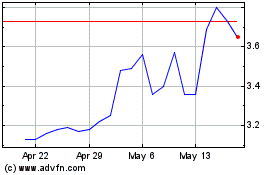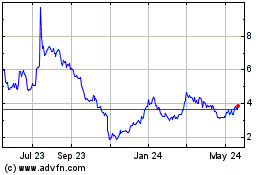Acumen Pharmaceuticals, Inc. (NASDAQ: ABOS), a clinical-stage
biopharmaceutical company developing a novel therapeutic that
targets toxic soluble amyloid beta oligomers (AβOs) for the
treatment of Alzheimer’s disease (AD), will present the
comprehensive clinical and biomarker results from its positive
Phase 1 INTERCEPT-AD study of sabirnetug (ACU193) in early AD
during an Emerging Science Session at the American Academy of
Neurology (AAN) 2024 Annual Meeting in Denver on April 16, 2024.
The results build upon Acumen’s prior presentations at the AD/PD™
2024 Annual Meeting and positive topline data first announced in
July 2023 and will be presented together for the first time with
expanded analysis.
A platform presentation, titled “A phase 1
study, INTERCEPT-AD, of ACU193: safety, target engagement, and
biomarker changes,” will take place on Tuesday, April 16, from
6:06-6:12 PM MDT within the ES2 – Emerging Science 2 track at the
Colorado Convention Center, Bluebird 1A, followed by a poster
presentation with more in-depth results from 6:25-7:00 PM MDT.
Sabirnetug is the first humanized monoclonal
antibody to clinically demonstrate selective target engagement of
AβOs, a soluble and highly toxic form of Aβ that accumulates early
in AD and is an early and persistent trigger of synaptic
dysfunction and neurodegeneration. Acumen is developing sabirnetug
as a potential best-in-class antibody treatment for early AD.
“For the first time, we’re presenting a
comprehensive set of safety, biomarker and target engagement data
from INTERCEPT-AD, which continue to support sabirnetug’s mechanism
and potential to offer differentiated safety and efficacy as a
next-generation treatment for people with early Alzheimer’s
disease,” said Eric Siemers, M.D., Chief Medical Officer of Acumen
and presenting author. “The results of this robust Phase 1 trial
give us hope that sabirnetug could have a safety and efficacy
profile that could make it an attractive option for a large number
of patients. We look forward to applying insights learned from
INTERCEPT-AD as we embark upon our ALTITUDE-AD Phase 2 trial for
sabirnetug.”
Sabirnetug Demonstrated Favorable Safety and
Tolerability Profile
The poster outlines that sabirnetug demonstrated
a favorable safety and tolerability profile in participants with
early AD with a relatively low incidence of ARIA-E. There were four
cases of asymptomatic ARIA-E and one symptomatic case among 48
participants who were treated with sabirnetug. Notably, none of the
six participants who were APOE Ɛ4 homozygotes experienced ARIA-E
despite making up 13% of all participants in the study. This
contrasts with other studies of amyloid-targeting monoclonal
antibodies where approximately 30 to 40 percent of participants who
are APOE Ɛ4 homozygotes experienced ARIA-E.
Target Engagement
Sabirnetug target engagement with AβOs in
cerebrospinal fluid (CSF) increased in a dose-dependent manner in
both single and multiple ascending dose groups. Central target
engagement approached the maximum at the highest doses of
sabirnetug administered. The results suggest that at these dose
levels, ACU193 concentrations approached saturation of AβOs, and
suggests active removal of target from the brain.
Sabirnetug Associated with Changes in CSF and
Plasma Biomarkers Indicating Downstream Effects on Amyloid, pTau
Species, and Synaptic Markers After Three Administrations
Sabirnetug treatment also changed a number of
CSF biomarkers in the multiple ascending dose cohorts, which are
indicative of amyloid pathology (Aβ42/40 ratio), tau pathology
(pTau181, pTau217), and synaptic injury (neurogranin, VAMP2).
Sabirnetug significantly lowered CSF neurogranin (-13.9%), VAMP2
(-8.1%) and pTau181 (-13.0%) concentrations and numerically
increased Aβ42/40 after three administrations of sabirnetug at 60
mg/kg once every 4 weeks (Q4W). Sabirnetug target engagement with
AβOs was significantly correlated with reduction of CSF
neurogranin. Additionally, plasma biomarkers for neuroinflammation
(GFAP) and tau pathology (pTau181, pTau217) were lower in the 10
mg/kg Q4W and 60 mg/kg Q4W groups compared to placebo. Furthermore,
nearly all patients treated with sabirnetug in the high dose
multiple-ascending dose cohorts showed reductions in plaque load
after three doses at 63 or 70 days. These results support
sabirnetug’s proposed mechanism of action and intended target
engagement of synaptotoxic AβOs.
A copy of the poster and presentation will be
available following the conference in the Investors section of the
Company's website at www.acumenpharm.com.
Acumen Remains On Track to Initiate
Additional Clinical Studies of Sabirnetug
Acumen remains on track to initiate the
ALTITUDE-AD placebo-controlled Phase 2 trial of sabirnetug in the
first half of 2024. Based on safety, target engagement and
biomarker data from the INTERCEPT-AD trial, Acumen has determined
sabirnetug doses of 35 mg/kg Q4W and 50 mg/kg Q4W in ALTITUDE-AD.
This study will also evaluate long-term changes in clinical
cognitive outcomes, biomarkers, and safety over 18 months.
Acumen also plans to initiate a Phase 1
bioavailability study to support a subcutaneous dosing option of
sabirnetug in mid-2024, as announced in November 2023.
About Sabirnetug (ACU193)
Sabirnetug (ACU193) is a humanized monoclonal
antibody (mAb) discovered and developed based on its selectivity
for soluble AβOs, which are a highly toxic and pathogenic form of
Aβ, relative to Aβ monomers and amyloid plaques. Soluble AβOs have
been observed to be potent neurotoxins that bind to neurons,
inhibit synaptic function and induce neurodegeneration. By
selectively targeting toxic soluble AβOs, sabirnetug aims to
directly address a growing body of evidence indicating that soluble
AβOs are an early and persistent underlying cause of the
neurodegenerative process in Alzheimer’s disease. Sabirnetug has
been granted Fast Track designation for the treatment of early
Alzheimer’s disease by the U.S. Food and Drug Administration.
About INTERCEPT-AD
INTERCEPT-AD was a Phase 1, U.S.-based, multi-center,
randomized, double-blind, placebo-controlled clinical trial
evaluating the safety and tolerability, and establishing clinical
proof of mechanism, of sabirnetug in patients with early
Alzheimer’s disease (AD). Sixty-five individuals with early AD
(mild cognitive impairment or mild dementia due to AD) enrolled in
this first-in-human study of sabirnetug. The INTERCEPT-AD study
consisted of single-ascending-dose (SAD) and
multiple-ascending-dose (MAD) cohorts and was designed to evaluate
the safety, tolerability, pharmacokinetics (PK), and target
engagement of intravenous doses of sabirnetug. More information can
be found on www.clinicaltrials.gov, NCT identifier
NCT04931459. About Acumen Pharmaceuticals,
Inc.
Acumen, headquartered in Charlottesville, VA,
with additional offices in Indianapolis, IN and Newton, MA, is a
clinical-stage biopharmaceutical company developing a novel
therapeutic that targets toxic soluble amyloid beta oligomers
(AβOs) for the treatment of Alzheimer’s disease (AD). Acumen’s
scientific founders pioneered research on AβOs, which a growing
body of evidence indicates are early and persistent triggers of
Alzheimer’s disease pathology. Acumen is currently focused on
advancing its investigational product candidate, sabirnetug
(ACU193), a humanized monoclonal antibody that selectively targets
toxic soluble AβOs, following positive results in INTERCEPT-AD, a
Phase 1 clinical trial involving early Alzheimer’s disease
patients. For more information, visit www.acumenpharm.com.
Forward-Looking Statements
This press release contains forward-looking
statements within the meaning of The Private Securities Litigation
Reform Act of 1995. Any statement describing Acumen’s goals,
expectations, financial or other projections, intentions or beliefs
is a forward-looking statement and should be considered an at-risk
statement. Words such as “potential,” “will” and similar
expressions are intended to identify forward-looking statements,
although not all forward-looking statements contain these
identifying words. Forward-looking statements include statements
concerning the therapeutic potential of Acumen’s product candidate,
sabirnetug (ACU193), and Acumen’s preparations with respect to its
plans to initiate a Phase 2 study. These statements are based upon
the current beliefs and expectations of Acumen’s management, and
are subject to certain factors, risks and uncertainties,
particularly those inherent in the process of discovering,
developing and commercializing safe and effective human
therapeutics. Such risks may be amplified by the impacts of
geopolitical events and macroeconomic conditions, such as rising
inflation and interest rates, supply disruptions and uncertainty of
credit and financial markets. These and other risks concerning
Acumen’s programs are described in additional detail in Acumen’s
filings with the Securities and Exchange Commission (“SEC”),
including in Acumen’s most recent Annual Report on Form 10-K, and
in subsequent filings with the SEC. Copies of these and other
documents are available from Acumen. Additional information will be
made available in other filings that Acumen makes from time to time
with the SEC. These forward-looking statements speak only as of the
date hereof, and Acumen expressly disclaims any obligation to
update or revise any forward-looking statement, except as otherwise
required by law, whether, as a result of new information, future
events or otherwise.
Investors: Alex Braunabraun@acumenpharm.com
Media:Jon YuICR
Westwicke AcumenPR@westwicke.com
Acumen Pharmaceuticals (NASDAQ:ABOS)
Historical Stock Chart
From Feb 2025 to Mar 2025

Acumen Pharmaceuticals (NASDAQ:ABOS)
Historical Stock Chart
From Mar 2024 to Mar 2025
